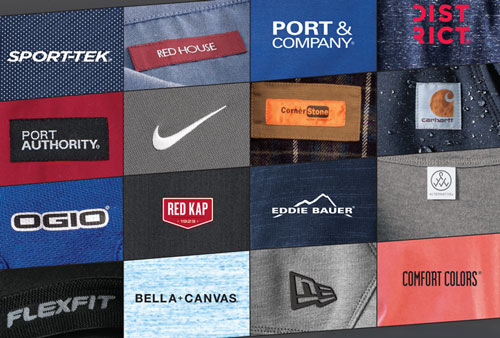Is Branded Clothing Really Better Because of the Fabric?
Is Branded Clothing Really Better Because of the Fabric?
Blog Article
Recognizing Clothing: The Relevance of Textile Choices in Your Closet
The choice of fabric in apparel plays an essential role in both appearances and performance. Various materials offer varying degrees of breathability, durability, and convenience, straight influencing the user's experience. Recognizing these subtleties can improve one's wardrobe markedly. Yet, many ignore just how these selections can affect not just personal design, yet also sustainability. What material decisions could redefine your closet and align it with both style and duty?
The Role of Textile in vogue and Performance

Common Textile Kinds and Their Attributes
When picking clothing, comprehending the features of usual fabric types is essential for making notified options. Cotton, a widely-used natural fiber, is recognized for its gentleness, breathability, and convenience, making it appropriate for laid-back wear and everyday garments. Bed linen, one more natural alternative, flaunts exceptional moisture-wicking properties and a distinct appearance, perfect for cozy climates.Wool, often preferred for its heat and sturdiness, varies in excellence; merino wool is soft against the skin, while coarser kinds are used for outerwear. Synthetic fabrics like polyester and nylon provide toughness and resistance to wrinkles, making them preferred for activewear and traveling garments. Blends, which combine all-natural and artificial fibers, can improve functionality while keeping convenience. By recognizing these material characteristics, people can choose clothes that aligns with their lifestyle and visual choices.
Breathability and Comfort: Selecting the Right Fabrics for Various Climates
Choosing the best materials for numerous climates can considerably improve convenience and total wearability. Breathable products are vital in hot environments, as they permit air blood circulation and wetness dissipation. Fabrics such as cotton, linen, and moisture-wicking synthetics efficiently attract sweat far from the body, keeping the wearer cool and completely dry. On the other hand, in cooler environments, thicker fabrics like wool or fleece give insulation while preserving breathability, guaranteeing heat without overheating.Additionally, the choice of material weight plays a crucial role; light-weight fabrics are better for summer season, whereas much heavier options are suited for wintertime wear. Comprehending the unique residential or commercial properties of each textile makes it possible for people to dress properly for varying weather condition problems. Eventually, selecting breathable and comfy fabrics tailored to certain climates can considerably improve day-to-day convenience and enhance the overall experience of wearing garments.
Sturdiness and Treatment: How Material Affects Longevity of Your Wardrobe
Selecting the ideal products can substantially influence the sturdiness and care requirements of a closet. Fabrics such as cotton and polyester are understood for their strength and convenience of maintenance, making them excellent for everyday wear. In contrast, delicate materials like silk and lace require even more cautious handling and specialized cleansing methods, which can increase the time and effort needed for care. Branded Clothing.Durability is additionally influenced by the textile's weave and coating; snugly woven textiles often tend to withstand deterioration much better than loosely woven alternatives. Additionally, synthetic blends usually supply improved sturdiness, integrating the very best high qualities of multiple fibers.Understanding the care guidelines for each and every fabric is vital, as improper drying or cleaning can check over here cause premature wear. Inevitably, selecting resilient materials can result in a longer-lasting closet, decreasing the frequency of substitutes and adding to a more sustainable fashion option
The Impact of Textile on Fit and Silhouette

Sustainable Textile Options: Making Eco-Friendly Choices
The effect of fabric expands beyond fit and shape to encompass ecological elements, prompting an expanding passion in sustainable material options. Environment-friendly materials, such as natural cotton, hemp, and Tencel, are getting traction among consumers that prioritize sustainability in their wardrobes. These materials are commonly generated with fewer chemicals and water, lowering their environmental footprint.Additionally, recycled fabrics, made from post-consumer waste, use an innovative solution to the textile market's air pollution issue. Brands increasingly embrace openness in their sourcing techniques, allowing consumers to make educated choices regarding their purchases.Choosing lasting materials not only supports moral techniques but also urges the garment industry to embrace even more liable production techniques. As recognition of environmental concerns climbs, individuals are urged to review the long-term influence of their textile options, promoting a motion in the direction of a more eco conscious and lasting method to fashion.
Elevating Design: Exactly How Material Can Transform a Clothing
While numerous might concentrate on shade and cut when selecting an outfit, the option of material plays a necessary role in boosting design and improving general look. Different materials share distinct state of minds and messages; as an example, silk exudes deluxe and elegance, while denim provides an informal, kicked back ambiance. The appearance and drape of a fabric can considerably change the silhouette, with organized materials providing a sleek look and softer ones creating a more fluid, loosened up aesthetic.Moreover, the weight of the textile affects wearability across periods. Lightweight fabrics like bed linen and cotton are ideal for summer, while larger materials such as woollen and velour offer warmth and sophistication in cooler months. Comprehending material properties, such as breathability and stretch, additionally encourages people to make enlightened selections that boost comfort without jeopardizing style. Inevitably, the right textile can change an attire from ordinary to extraordinary, making it a crucial factor to consider in any type of closet.
Often Asked Inquiries
Just how Do I Recognize the Textile Web Content of My Clothes?
To identify material content, one can examine care labels, conduct shed web tests for fiber identification, or consult material examples. These techniques help differentiate products, ensuring educated selections for clothes care and upkeep in everyday wear.
Can Fabric Choice Affect My State Of Mind or Confidence?
Material choice can considerably affect a person's mood and confidence. Branded Clothing. Certain products may evoke sensations of comfort or style, while others can really feel limiting or uncomplimentary, eventually affecting self-perception and emotional well-being throughout the day
What Fabrics Are Ideal for Sensitive Skin?
For individuals with delicate skin, all-natural textiles like bamboo, bed linen, and cotton are often recommended. These materials are breathable, hypoallergenic, and much less most likely to cause irritation, making them ideal choices for convenience and skin wellness.
Exactly how Do I Appropriately Wash and Treatment for Different Fabrics?
To correctly wash and care for various textiles, one have to think about each material's details needs, including temperature level setups, cleaning agents, and drying approaches, making sure durability and preserving the fabric's initial top qualities for optimal usage.
Are There Particular Fabrics for Athletic or Performance Wear?
Sports or efficiency wear typically makes use of materials such as polyester, spandex, and nylon. These products are made for moisture-wicking, breathability, and adaptability, improving activity and comfort during physical activities while offering sturdiness and assistance. On the other hand, in chillier climates, thicker textiles like wool or fleece supply insulation while keeping breathability, making sure heat without overheating.Additionally, the choice of fabric weight plays a vital duty; light-weight textiles are more suitable for summer, whereas heavier alternatives are matched for winter season wear. In contrast, delicate materials like silk and lace need more mindful handling and specialized cleansing approaches, which can increase the time and effort required for care.Durability is additionally influenced by the textile's weave and coating; snugly woven fabrics have a tendency to resist wear and tear far better than loosely home woven alternatives. In comparison, stiff materials can limit motion but offer a traditional, polished look.Moreover, the density and texture of the textile can influence the visual perception of body shape. The impact of material prolongs beyond fit and silhouette to incorporate ecological variables, prompting a growing passion in sustainable material selections. The texture and drape of a fabric can dramatically modify the shape, with structured materials providing a polished look and softer ones producing a more fluid, unwinded aesthetic.Moreover, the weight of the fabric affects wearability throughout seasons.
Report this page